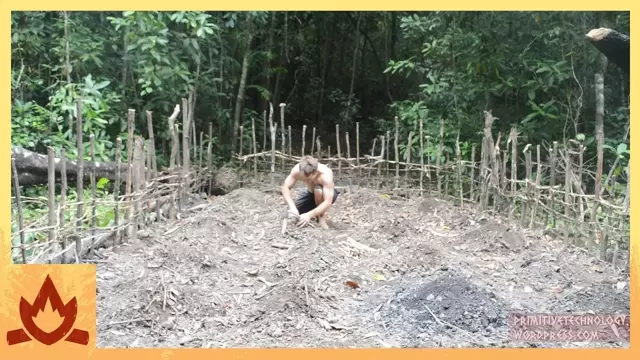2017-02-24
[public] 12.2M views, 202K likes, dislikes audio only
In this video I build a garden to grow Cassava and yams, two staple food crops. Cassava is a shrub that develops large edible roots. Yams are a climbing vine that produce large, edible underground bulbs and smaller aerial bulbs on their vines.
I had 5 huts, but the wattle and daub hut (from the first video uploaded on this channel nearly 2 years ago) became dilapidated. I abandoned it in favour of the other huts I built and neglected the roof. This let water in destroying a wall. Also, the sweet potato patch behind it had a tree fall across it destroying the fence. So I demolished them both to make one large garden.
After removing the fence I set a fire under the fallen tree to burn it in half rather than spend the effort of cutting it with stone tools. After burning almost all the way through, it rained. So I came back later and cut through the rest of the log with stone tools. I eventually broke the tree in half. Using smaller logs as levers I moved the tree out of the garden clearing the space for the garden.
I then collected wood and built a simple fence that was woven loosely together with vine. The fence needs only to discourage large animals from entering to prevent them causing damage. Most times pigs and wallabies don’t know that food is growing in the garden and won’t try and enter if they see no reason to. Or at least that worked for the sweet potatoes so we’ll see if it works this time.
For the yam and cassava planting material I travelled far down stream to the site of my old stone hut that I built over 10 years ago. It had a corbelled dome roof that was damaged when a tree fell on it during a cyclone and it came down a few months later. The thick walls however have stayed standing for about a decade though.
Yams and cassava grew wild at this site which is one of the reasons I built the stone hut there. These plants are not native to Australia but grow wild here after having escaped from people’s gardens (similar to how wild pigs live here now after escaping from farms). The planting material for the yams are the bulbs that grow on the vines. The planting material for cassava are simply 25 cm long pieces of stem.
On returning to the garden, a scrub turkey was seen digging in the mounds. Protected by law, this bird has lost its fear of humans and in this case I’ve semi-domesticated it. Originally it was attracted to soil I dug up for the worms it exposed. I started leaving a pot out with small sweet potatoes in it for it to eat and now it investigates any pottery I leave for food. Now it visits my projects and will only leave if bored or chased away. I suppose this is similar to how chickens were domesticated, in fact bush turkeys and chickens are related and will produce hybrid offspring.
Unfortunately, it has learned that the garden contains food. Originally, I was only going to plant yams but I saw the turkey digging them up and eating them. So, I planted cassava in the mounds so that the turkey would be discouraged by finding only wooden stems to peck at. I secretly planted the yams along the fence of the garden because the turkey only thinks the mounds contain yams. They can’t smell very well and only find food by sight and learned behavior.
I planted the cassava in mounds 1 meter apart by pushing them flat into the soil. I planted the yams at intervals along the fence so they could use it as a trellis. 32 cassava stems and 12 yams were planted. Then a storm began and watered the garden. In less than a week the cassava had sprouted shoots and began to grow. The yams will take longer as I planted them deeper.
Cassava produces the most calories per time and space of any plant apart from sugar cane and sugar beet. But it requires much less fertiliser and effort. A hectare of cassava produces enough calories in 2 days to sustain a person for 1 year. It takes a year to come to harvest but will stay in the ground for a year without becoming woody. The tubers are high in starch and are what tapioca is made from.
This variety is called sweet cassava (actually not bitter cassava, it doesn’t taste sweet but starchy instead) and it needs to be boiled for 20 minutes to get rid of some cyanide it contains. The bitter variety contains such high levels that it kills if eaten raw and requires more extensive treatment to eat. There isn’t much nutrition in cassava other than the large amount calories it contains so other food would be required to provide protein and nutrients.
After I harvest the cassava I planted I’ll try fermenting it (which adds nutrition), drying it and pounding it into flour to make flat bread. Cassava flour has the same energy content as wheat flour, stores well and tastes somewhat similar. Or I could just cook it and eat it straight from the garden. I’ll use the yams like potatoes when they’re ready.
http://www.penguinrandomhouse.com/primitive-technology
/youtube/video/_ZXUCQc2Z78
/youtube/video/e5nfrehyWDM?t=139
/youtube/channel/UCAL3JXZSzSm8AlZyD3nQdBA
/youtube/video/lMZY_9QNe4I
/youtube/video/nG-rNHgFxhs
http://www.penguinrandomhouse.com/primitive-technology

